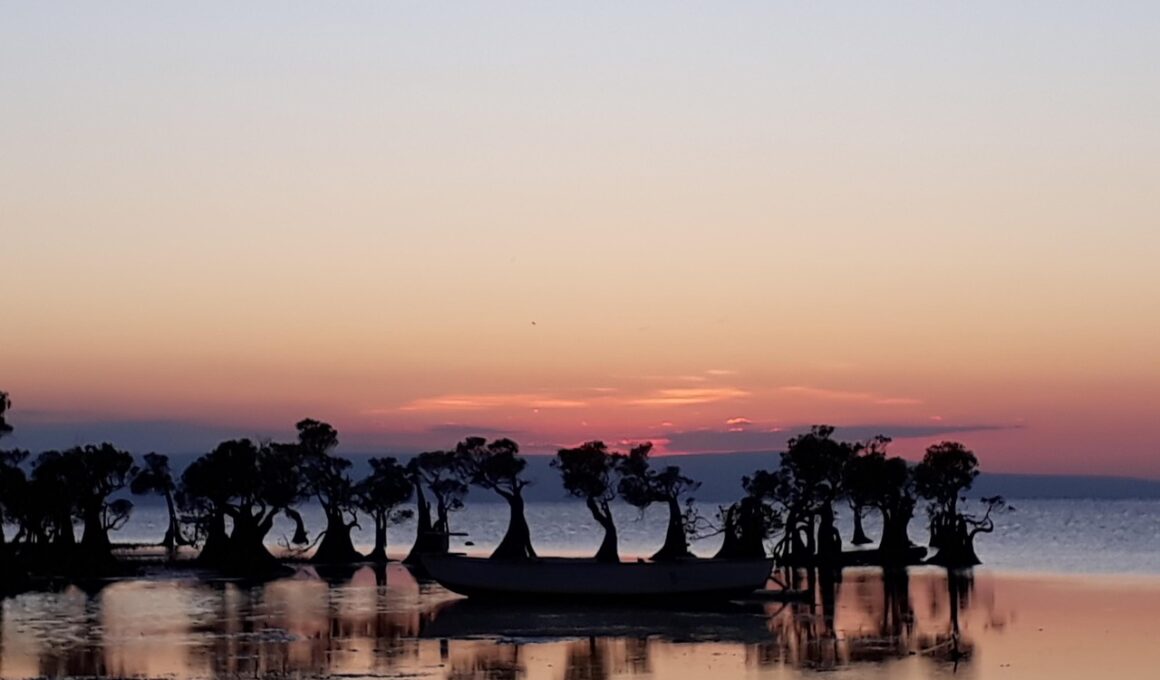Mangrove Conservation as a Natural Barrier Against Saltwater Intrusion
Mangroves are crucial ecosystems that play an essential role in preventing saltwater intrusion, especially in coastal areas. These trees grow along the coastline and create a buffer zone that protects inland freshwater resources from the encroachment of seawater. This process is increasingly vital as climate change elevates sea levels and increases salinity in surrounding waters. Conservation efforts focused on mangrove restoration can significantly enhance the resilience of coastal communities. Implementing policies that promote the protection and rehabilitation of these natural barriers is necessary for sustainable development. Additionally, mangroves provide habitat for a variety of marine life, further supporting biodiversity. Their extensive root systems effectively stabilize coastlines, preventing erosion while trapping sediment. Moreover, these ecosystems can absorb carbon dioxide, also helping mitigate climate change effects. In this regard, engaging local communities in conservation initiatives is pivotal. Education about the benefits of mangroves fosters stewardship among residents, ensuring the long-term sustainability of these vital landscapes. Strengthening policies that support mangrove conservation is essential for safeguarding freshwater resources and enhancing environmental fitness against saltwater intrusion.
Another critical aspect involves understanding the socioeconomic impacts of mangrove loss. Coastal communities often rely on these ecosystems for their livelihoods, which include fishing and ecotourism opportunities. The disappearance of mangroves can lead to decreased fish populations and diminished coastal resilience, exacerbating economic struggles. Therefore, creating a balance between development and conservation is necessary for community sustainability. Governments and nonprofits should collaborate to establish programs that emphasize the importance of mangrove ecosystems. By providing financial support and resources for restoration projects, we can facilitate transitions towards sustainable practices. Additionally, public awareness campaigns can highlight the significance of mangroves in climate adaptation strategies. Communities engaged in mangrove protection can see improved economic resilience through enhanced fish stocks and sustainable tourism. It is essential to report successes, showcasing the benefits of sustainable practices and inspiring further action. Conservation actions need to be rooted in the community’s needs and input to be truly effective. Engaging local stakeholders in designing restoration projects fosters investment and long-term commitment to mangrove health and sustainability.
The Role of Global Organizations in Mangrove Conservation
Several global organizations are actively working to promote mangrove conservation efforts across multiple regions. Initiatives spearheaded by these entities focus on creating international frameworks and providing funding for local projects. Organizations like the United Nations and several non-governmental groups play a pivotal role in marshaling resources and raising awareness regarding mangrove ecosystems. Their efforts often involve conducting research to better understand the ecological benefits of mangroves and disseminating this knowledge through various outreach strategies. Collaboration among nations is vital, especially as saltwater intrusion impacts multiple coastal environments worldwide. Sharing best practices and success stories enables countries to implement effective conservation measures. As international cooperation on environmental issues grows, fostering partnerships among governments, conservationists, and communities is paramount. This collective approach can address loss due to deforestation and climate change threats. Moreover, global attention to mangrove conservation encourages investment in innovating solutions, such as sustainable aquaculture and coastal engineering methods that complement mangrove ecosystems. Ultimately, the success of these initiatives can help secure the health of coastal habitats and mitigate the impacts of saltwater intrusion.
Restoring mangrove ecosystems involves various approaches that contribute to their resilience against environmental threats. Key strategies include reforestation, habitat protection, and improving watershed management. Reforestation initiatives focus on planting native mangrove species while actively engaging local communities in the process. By involving these stakeholders, projects have a higher success rate and foster connection to the ecosystem. Habitat protection aims to mitigate human impacts such as pollution and unsustainable coastal development. Effective management of nearby watersheds is crucial, as activities within these areas significantly affect mangrove health. Encouraging sustainable agricultural practices can reduce runoff pollution that negatively influences mangrove ecosystems. Erosion control through proper watershed management helps maintain the integrity of mangrove habitats. Furthermore, innovative techniques such as creating marine protected areas can significantly enhance the health of adjacent mangrove forests. This leads to improved biodiversity and reinforces their role as a barrier against saltwater intrusion. Collaborating with multiple stakeholders, including governmental and non-governmental organizations, plays a pivotal role in advancing these restoration efforts and ultimately protecting coastal communities from the adverse effects of climate change.
Community-Based Approaches to Mangrove Conservation
Involving local communities in mangrove conservation is vital for achieving long-lasting results. Community-based approaches empower residents to take an active role in protecting their coastal environment. By fostering participation, these strategies create a sense of ownership and responsibility, ensuring that conservation efforts are maintained over time. Through educational programs, locals can learn the ecological functions of mangroves and the importance of conserving these habitats. Additionally, training in sustainable practices can lead to improved livelihoods while preserving the environment. For instance, developing ecotourism initiatives centered on mangrove ecosystems allows communities to benefit economically without harming their surroundings. Engaging stakeholders in monitoring and evaluation processes further strengthens community involvement. Regular assessments can identify areas in need of restoration, allowing communities to prioritize actions effectively. Moreover, collaboration with local governments and NGOs can amplify efforts as resources are pooled together. This holistic approach ensures that various perspectives input into mangrove conservation, leading to adaptive management techniques tailored to local conditions. These participatory efforts collectively contribute towards addressing saltwater intrusion while enhancing the resilience of coastal ecosystems.
Technological advancements are increasingly being utilized in the field of mangrove conservation to tackle saltwater intrusion. Innovative tools such as satellite imagery and remote sensing allow for the monitoring of mangrove health and ecosystem changes over time. By analyzing data from these technologies, researchers can identify areas of mangrove loss and prioritize restoration efforts. Furthermore, these advancements enable better understanding of the impacts of sea level rise and climate change on coastal ecosystems, providing valuable insights for future planning. Drones can also be employed to carry out reforestation tasks with precision, ensuring that native mangrove species are planted where needed. The integration of technology into conservation practices encourages data-driven decision-making, ultimately improving the effectiveness of management strategies. Mobile applications can facilitate community reporting of environmental changes, fostering engagement and raising awareness about conservation issues. Enhancing communication through digital platforms allows for greater knowledge sharing among stakeholders, strengthening conservation networks. By utilizing these tools, communities and organizations can combat saltwater intrusion risks while promoting the thriving of healthy mangrove ecosystems, illustrating the importance of embracing innovation in environmental conservation.
The future of mangrove ecosystems is contingent upon concerted efforts to address the threats posed by climate change and human activity. Understanding the critical role mangroves play in coastal protection and environmental health is essential for effective action. Continued research into the benefits of these ecosystems will support advocacy for their conservation and restoration. As awareness grows, policies that reflect the value of mangrove ecosystems will become more developed, leading to improved funding for restoration initiatives. Collaborative efforts among governments, NGOs, and local communities will shape effective management strategies. Moreover, the importance of economic incentives for protecting mangroves cannot be understated. Promoting sustainable tourism, fisheries management, and carbon credit systems fosters greater investment in mangrove conservation. Active engagement in conservation efforts will ensure the survival of these essential ecosystems for future generations. Strengthening local capacities will further enable communities to adapt their practices, forging resilience in the face of environmental change. Lastly, fostering global awareness and commitment will harness collective action toward preserving mangrove habitats, reinforcing their role as natural barriers against saltwater intrusion and environmental imbalance.
In conclusion, mangrove conservation holds immense significance in combating the effects of saltwater intrusion and promoting ecological balance. It serves not only as a buffer to coastal communities but also supports numerous species, thus maintaining biodiversity. Prioritizing the restoration and protection of mangrove ecosystems is necessary for environmental resilience and community wellbeing. With effective management practices, collaborative partnerships, and continued advocacy for their importance, it is possible to tackle the challenges posed by climate change. Grassroots initiatives engaging local communities will enhance stewardship, ensuring lasting change. Investing in education, technology, and sustainable practices will foster a comprehensive approach to mangrove conservation. Highlighting success stories and sharing knowledge will further inspire initiatives worldwide. By uniting efforts across sectors and borders, we can better equip ourselves to protect these vital ecosystems. The synergy between human action and nature can bolster resilience against ongoing environmental challenges such as saltwater intrusion. Ultimately, the combined actions towards mangrove conservation will contribute significantly to a sustainable future, underlining the need for urgent and coordinated global efforts to safeguard these precious coastal resources.


